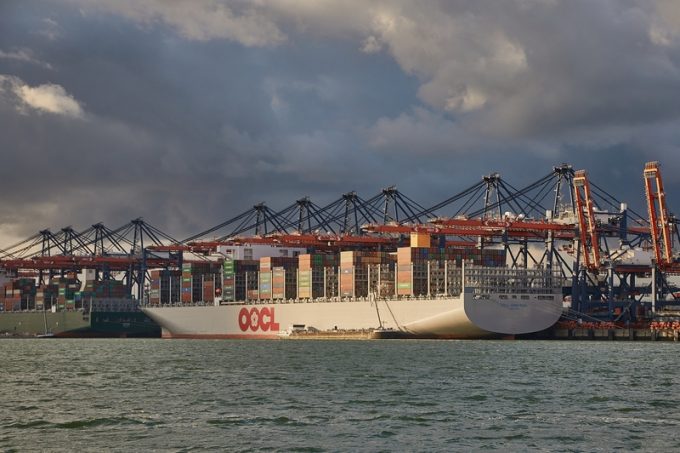OOCL loses market share on Asia-EU, but soaring rates prop up top line
The impact of soaring spot freight rates made itself felt on OOCL’s top line after ...
TFII: SOLID AS USUALMAERSK: WEAKENINGF: FALLING OFF A CLIFFAAPL: 'BOTTLENECK IN MAINLAND CHINA'AAPL: CHINA TRENDSDHL: GROWTH CAPEXR: ANOTHER SOLID DELIVERYMFT: HERE COMES THE FALLDSV: LOOK AT SCHENKER PERFORMANCEUPS: A WAVE OF DOWNGRADES DSV: BARGAIN BINKNX: EARNINGS OUTODFL: RISING AND FALLING AND THEN RISING
TFII: SOLID AS USUALMAERSK: WEAKENINGF: FALLING OFF A CLIFFAAPL: 'BOTTLENECK IN MAINLAND CHINA'AAPL: CHINA TRENDSDHL: GROWTH CAPEXR: ANOTHER SOLID DELIVERYMFT: HERE COMES THE FALLDSV: LOOK AT SCHENKER PERFORMANCEUPS: A WAVE OF DOWNGRADES DSV: BARGAIN BINKNX: EARNINGS OUTODFL: RISING AND FALLING AND THEN RISING

OOCL carried fewer boxes but improved its revenue in the second quarter, providing the industry with some hard evidence that ocean carriers successfully managed the demand turbulence of the pandemic.
The Cosco subsidiary saw liftings decline 4.6% in the quarter, compared with the same period of the previous year, to 1,688,055 teu. However, turnover was up 1.1% to $1.58bn.
The operational data released by OOIL is a useful bellwether for the upcoming carrier results season and suggests that, despite the impact of Covid-19 on demand, liner profitability for Q2 and first half is likely to be considerably better than expected.
On OOCL’s biggest trading region by volume, intra-Asia/Australasia, the teu count was down 6.4% to 726,303, while revenue was up 0.7% to $484m.
The transpacific, the carrier’s second-biggest sector, saw liftings fall 2.2%, to 491,526 teu, and revenue ahead slightly, by 0.2% to $623m.
However, the biggest improvement in tradelane profitability came on Asia-Europe, where a 6.2% fall in liftings in the quarter to 343,982 teu was set against an impressive 8.8% gain in revenue to $336m.
The only blot on OOCL’s copybook was on the hitherto robust transatlantic tradelane, which was hit by simultaneous consumer lockdowns in Europe and the US during the quarter.
Although the carrier somehow managed to transport 2.2% more containers than in Q2 19, at 126,244 teu, earnings during the quarter slumped a worrying 9.2% to $140m, as discounting ensued.
Overall OOCL saw its average revenue per teu improve quarter on quarter by 5.9% to $938 per teu.
Blank sailings reduced OOCL’s loadable capacity by 6.4%, however the vessels that sailed achieved a 1.6% higher utilisation level than in the year before.
At the half-year stage, OOCL carried 2.6% fewer containers than in the first half of 2019, at 3,286,477 teu, but the carrier’s revenue improved by 3.2% to $3.12bn.
Last year, OOIL reported a net profit of $195m, after excluding the one-off $1.15bn book profit from the sale of its Long Beach Container Terminal – a regulatory condition from the US of the Hong Kong-based shipping group’s takeover by Cosco.
However, at the time of the publication of its annual results in March, it described the outlook for its liner business as becoming “more pessimistic” as coronavirus continued to spread around the world, impacting consumer demand.
Indeed, pessimism was rife throughout the industry and, against an anticipated reduction in demand of up to 20% year on year, analysts predicted very heavy full-year losses for shipping lines.
Subsequently however, the aggressive capacity reductions by carriers kept supply tight, and not only supported freight rates but drove them higher. And unlike previous recessions carriers resisted the urge to discount prices on all lanes and start a rates war.
For instance, the widely followed Shanghai Containerized Freight Index (SCFI) cumulative index of the main tradelanes from China is currently riding 30% higher than 12 months ago.
Both Maersk and Hapag-Lloyd have upgraded their earnings guidance for the quarter and half-year, with the latter advising a preliminary first-half ebit of €500m, compared with €389m for the same period in 2019.
Comment on this article